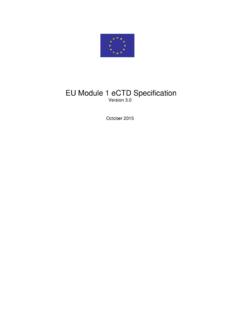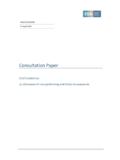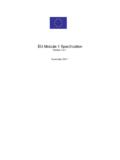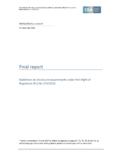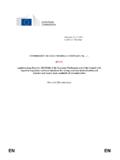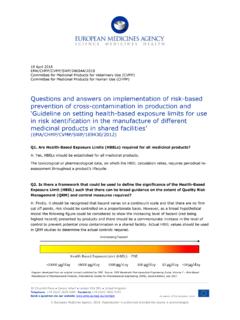Transcription of Draft agreed by QWP, BWP February 2015
1 30 Churchill Place Canary Wharf London E14 5EU United Kingdom An agency of the European Union Telephone +44 (0)20 3660 6000 Facsimile +44 (0)20 3660 5555 Send a question via our website European Medicines Agency, 2015. Reproduction is authorised provided the source is acknowledged. 3 February 2015 1 EMA/CHMP/QWP/245074/2015 2 Committee for Human Medicinal Products (CHMP) 3 Guideline on manufacture of the finished dosage form 4 Draft 5 6 Draft agreed by QWP, BWP February 2015 Adopted by CHMP for release for consultation 23 April 2015 Start of public consultation 09 July 2015 End of consultation (deadline for comments) 09 January 2016 agreed by QWP, BWP <Month YYYY> Adopted by CHMP <DD Month YYYY> Date for coming into effect <DD Month YYYY> 7 This guideline replaces the Note for Guidance on Manufacture of the Finished Dosage Form 8 (CPMP/QWP/486/95) 9 Comments should be provided using this template.
2 The completed comments form should be sent to 10 Keywords Manufacture, drug product Guideline on manufacture of the finished dosage form EMA/CHMP/QWP/245074/2015 Page 2/13 Guideline on manufacture of the finished dosage form 11 Table of contents 12 13 Executive summary .. 3 14 1. Introduction (background) .. 3 15 2. 3 16 3. Legal basis .. 3 17 4. Manufacture .. 4 18 Manufacturer(s) .. 4 19 Batch Formula .. 4 20 Description of Manufacturing Process and Process Controls .. 5 21 Controls of Critical Steps and Intermediates .. 7 22 Process Validation and/or 8 23 Definitions .. 9 24 References .. 10 25 Annex .. 11 26 Guideline on manufacture of the finished dosage form EMA/CHMP/QWP/245074/2015 Page 3/13 Executive summary 27 This guideline replaces the note for guidance on the manufacture of the finished dosage form 28 (CPMP/QWP/486/95). The note for guidance has been updated to reflect changes to the format and 29 content of the Common Technical Document (CTD) Module 3 dossier.
3 It also addresses current 30 manufacturing practices in terms of complex supply chains and worldwide manufacture. In addition, 31 the content and principles of the ICH Q8 guideline (ref 1) is also taken into account. 32 This guideline does not introduce new requirements on authorised medicinal products for human use. 33 However as stated in article 23 of Directive 2001/83/EC (ref 2) after an authorisation has been issued, 34 the authorisation holder must, in respect of the methods of manufacture and control take account of 35 scientific and technical progress and introduce any changes that may be required to enable the 36 medicinal product to be manufactured and checked by means of generally accepted scientific methods. 37 1. Introduction (background) 38 The objective of the guideline on the manufacture of the finished dosage form is to provide clarification 39 on the type and level of information that should be included in the CTD Module 3 of the marketing 40 authorisation application (MAA) dossier with respect to the manufacturing process description.
4 This 41 description should include information about critical steps and intermediates and provides a link 42 between the pharmaceutical development, the proposed control strategy and process validation. The 43 guideline also addresses aspects related to increased outsourcing and new manufacturing practices 44 such as complex manufacturing chains or issues with prolonged holding times and transportation 45 conditions. Detailed information about requirements of sterilisation processes is provided in a separate 46 guideline. 47 2. Scope 48 This guideline is applicable to the manufacture of the finished dosage form of chemical and herbal 49 medicinal products for human use intended for marketing authorisation. It also applies to variations for 50 authorised products in cases where changes to the manufacturing process affecting the MA are 51 proposed. 52 The principles described are in general also applicable to biological medicinal products.
5 Due to the 53 nature of advanced therapy medicinal products (ATMPs), the guideline is not applicable to these. 54 This guideline does generally not apply to radiopharmaceuticals; however, the principles of this 55 guideline may be applied where relevant. 56 Application of this guideline to the manufacture of investigational medicinal products is not intended, 57 but the principles of this guideline may be applied. 58 3. Legal basis 59 This guideline should be read in conjunction with Directive 2001/83/EC Article (d) (ref 2) where it 60 is stated that the application for a marketing authorisation shall contain a description of the 61 manufacturing method. 62 Guideline on manufacture of the finished dosage form EMA/CHMP/QWP/245074/2015 Page 4/13 The requirements on the description of the manufacturing method in the CTD Module 3 of marketing 63 authorisation dossier are described in Annex 1, Part 1 (section ) to this Directive and will be 64 further elaborated in this guideline.
6 65 4. Manufacture 66 The headings of this guideline follow the structure of the CTD format Module 3, Section 67 Manufacture. 68 Only product specific aspects of manufacture need to be described and included in the MA-dossier; 69 general elements of Good Manufacturing Practice (GMP), (ref 3) should not be included. 70 Manufacturer(s) 71 For each stage of the manufacturing process (including the assembly and testing), details should be 72 given of all the individual sites involved (including those from the same company). The name, address 73 and responsibility of each manufacturer, including contractors should be provided. 74 The company responsible for the final release of the product onto the market shall be specified. Only 75 those sites that are involved in the manufacture and control of finished product until release need to be 76 included. 77 Batch Formula 78 The batch formula for the intended batch size should be stated.
7 In case a range of batch sizes is 79 proposed, the batch formula should be provided for at least the highest and lowest batch sizes. 80 An application for a range of batch sizes should be adequately justified taking into account the 81 guidance provided in the guideline on process validation (ref 4). 82 If the bulk product is assembled into different presentations or packs, the production batch size should 83 be defined by the original bulk before any division. When the length of the subsequent processes and 84 assembly is considered critical ( filling for aseptically manufactured products), the division pattern 85 should be indicated. 86 The batch size for a product to be marketed should normally be compatible with qualified industrial 87 equipment. It should be sufficient enough to allow process capability to be established. For example, a 88 commercial batch size for solid oral dosage forms should be at least 100,000 units unless justification 89 is provided ( orphan drugs).
8 90 If sub-batches are prepared and combined for subsequent processing, their formulae and the number 91 of sub-batches per intended batch size should be stated. In addition, if a batch is sub-divided towards 92 the end of the process to reflect equipment processing capability, this should be clearly indicated. The 93 number of sub-batches per intended batch size should be justified. 94 In case of continuous manufacture, the information about batch size in traditional terms might not be 95 relevant; however information how a batch is defined should be provided. The expected size of one 96 campaign ( period of time) should be stated. 97 The names, quantities and reference to the quality standards of all ingredients used in the course of 98 the manufacture should be stated. This includes ingredients which are removed from the product 99 during the production process, such as granulation liquids, solvents and gases.
9 100 Guideline on manufacture of the finished dosage form EMA/CHMP/QWP/245074/2015 Page 5/13 Ingredients that may not always be used should also be mentioned, such as acids and alkalis for pH 101 adjustment. Overages must be clearly indicated in quantitative terms and justified in the 102 pharmaceutical development section of the dossier. 103 In justified cases, upper and lower acceptance limits for the actual quantity of each ingredient could be 104 stated. 105 When the quantity of an active ingredient to be used is calculated from the actual assay value of the 106 batch of that active ingredient ("factorisation"), this should be stated and justified. If another 107 ingredient is used to keep the total mass per batch equal to the quantity provided for in the batch 108 manufacturing formula, this should also be indicated. 109 Description of Manufacturing Process and Process Controls 110 General aspects 111 A narrative description of the full manufacturing process should be provided, accompanied by a flow 112 chart describing each step of the process with respective in-process controls where relevant and 113 showing at each stage where materials enter the process.
10 In case a Design Space is proposed, this 114 should be presented in a transparent manner. 115 It is important that the process descriptions are comprehensive, suitably detailed and describe process 116 steps in a sequential manner including batch size(s) and equipment type(s) and size(s) where 117 appropriate. In case of continuous manufacturing, the description of manufacturing process is expected 118 to be provided in the same way. E mphasis should be given on frequency of in-process controls and it 119 should be clearly stated when the release testing is performed. 120 The manufacturing process description should be adequately justified by development, in particular 121 any process operating conditions or ranges. In addition, and where relevant, any required 122 environmental conditions during manufacture should be stated low humidity for an effervescent 123 tablet. 124 The steps and points at which process controls, intermediate tests or final product controls are 125 conducted should be identified.










